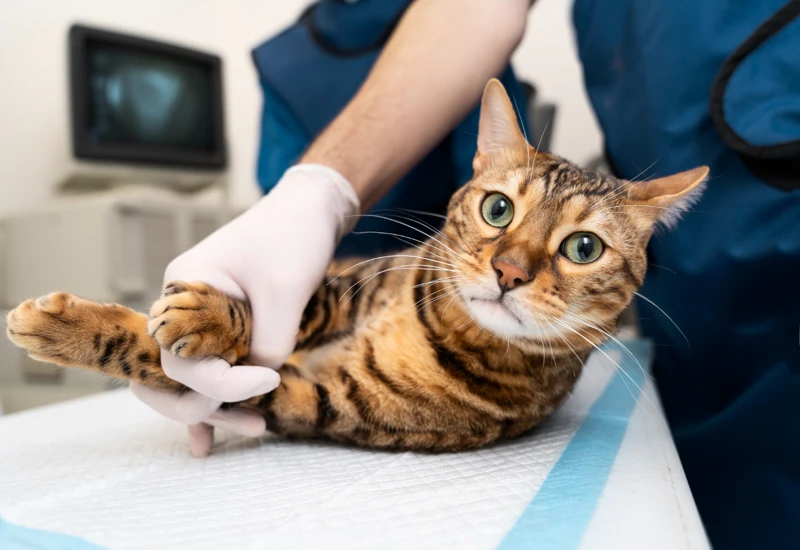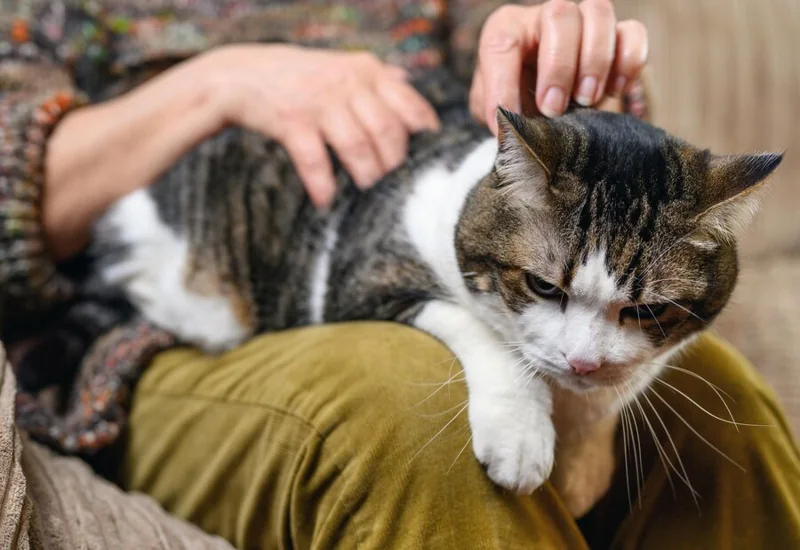When Is It Too Late to Spay a Cat? Understanding the Optimal Age for Spaying
Updated: 26 May 2024
527

Hello, dear cat lovers! If you’re anything like me, your cat is more than just a pet – it’s part of the family. And as with any family member, their health and well-being are the top priority. That’s why the issue of neutering – the surgical removal of a cat’s reproductive organs – is so important.
But one question that is often asked is “When is it too late to spay a cat?”. In this guide, we’ll cover all you need to know about spaying, its importance when to do it, and the ideal time for this procedure.
Understanding Spaying in Cats

Before we jump into the specifics, let’s take a moment to understand what spaying really means and why it’s essential for both male and female cats.
Spaying, also known as ovariohysterectomy, is a surgical procedure that involves the removal of a female cat’s ovaries and uterus. This might sound a bit daunting, but it’s a routine procedure performed by veterinarians worldwide. The primary purpose of spaying is to prevent your cat from reproducing and going into heat.
If you’ve ever experienced a female cat in heat, you know it can be quite a spectacle, with behaviors ranging from excessive meowing to marking territory in an attempt to become pregnant. Spaying puts an end to these behaviors, leading to a calmer household.
And just to clear any confusion, while spaying is for female cats, the equivalent for males is called neutering, which involves the removal of the testicles, and is crucial because male cats don’t need to become pregnant to contribute to overpopulation.
Key Considerations and Impacts of Spaying Cats
| Key Point | Details |
|---|---|
| Optimal Age for Spaying | 5 to 6 months |
| Increased Risks with Late Spaying | Yes |
| Risk of Ovarian and Uterine Cancers after Spaying | Eliminated |
| Risk of Mammary Tumors after Spaying | Significantly Reduced |
| Behavioral Changes after Spaying | Typically Positive |
| Weight Gain after Spaying | Usually due to Overfeeding and Lack of Exercise |
When Should a Female Cat Be Spayed?
Now, onto the million-dollar question: when should you spay or neuter your cat? The general consensus among veterinarians is that a female cat should ideally be spayed before her first heat cycle, which typically happens around 5 to 6 months of age.
But what if you’ve missed this window? Is it too late? The answer is no. It’s never truly “too late” to spay a cat. However, spaying at a later age may come with increased risks and potential behavioral adjustments, hence the question of how old is too old often arises.
So, it’s always best to consult with your vet to determine the best course of action for your furry friend, including the best age for this procedure.
Why Spaying Female Cats Is Important
Spaying female cats is crucial for several reasons. First and foremost, it helps control the cat population by preventing unwanted litters, underscoring the importance of the spay and neuter movement.
This is a significant contribution to animal welfare, as it helps reduce the number of cats that end up in shelters or on the streets.
Secondly, spaying eliminates the risk of ovarian and uterine cancers and significantly reduces the risk of mammary tumors. So, it’s not just about preventing kittens; it’s also about keeping your cat healthy!
Benefits of Spaying Female Cats

Prevention of Ovarian and Uterine Cancers
One of the major benefits of spaying is that it eliminates the risk of ovarian and uterine cancers. Considering how serious these conditions can be, that’s a huge plus!
These types of cancers can be life-threatening and often require extensive treatment, particularly if not addressed through early spay or neuter procedures. By spaying your cat, you’re taking a proactive step in preventing diseases like pyometra.
Reduction in the Risk of Breast Cancer
Spaying a cat before her first heat cycle can virtually eliminate the risk of mammary cancer, showcasing why spaying or neutering your cat is not just a phrase but a preventative health measure.
This is particularly important because mammary cancers in cats can be very aggressive, and spaying at the best age can lessen these risks.
In fact, about 85% of mammary tumors in cats are malignant, meaning they can spread to other parts of the body. By spaying your cat early, you’re significantly reducing her risk of developing this dangerous disease.
In addition to these health benefits, spaying also contributes to reducing overpopulation and homeless pets, making it a crucial aspect of the spay and neuter discussion. By preventing unwanted litters, spaying helps decrease the number of cats that end up in shelters or on the streets.
Why Should I Get My Cat Fixed?
There are several reasons why you should consider getting your cat fixed, especially neuter procedures for male cats and spaying for female ones.
First, neutering your cat helps control the cat population by preventing unwanted litters. Second, neutered cats, whether male or female, are generally calmer as they do not experience heat cycles or the urge to spray.
This can also prevent behaviors associated with heat, such as yowling and marking territory. Lastly, neutering eliminates the risk of testicular cancer and significantly reduces the risk of mammary tumors.
Ideal Timing for Spaying Cats
The optimal age for spaying a cat is before she reaches sexual maturity, which is around five months of age. Early spaying is associated with faster recovery, lower anesthesia risks, and a reduced likelihood of behavioral problems.
Factors Influencing the Timing of Spaying
The decision to spay a cat and the timing of the procedure can be influenced by various factors, including the cat’s age, health status, and behavioral considerations. Delaying spaying can lead to health risks and behavioral issues.
Addressing Common Questions and Myths
There are several myths associated with spaying cats. One common myth is that a cat should have a litter or heat before being spayed, but veterinary professionals strongly dispute this.
However, the misconception that male cats don’t need to be neutered because they cannot become pregnant is not true and can contribute to the overpopulation problem.
Another misconception is that spaying can cause personality changes and weight gain, though these effects are often manageable and minimal compared to the benefits of having your cat neutered.
In reality, any changes in behavior are typically positive, and weight gain is usually due to overfeeding and lack of exercise.
Importance of Spaying at Any Age
Regardless of a cat’s age, spaying is important. Even for older cats, spaying can still provide benefits, such as preventing certain cancers and health conditions. It’s never truly “too late” to spay a cat.
Key Life Stages and Care Guidelines for Cats
| Age | Key Information |
|---|---|
| 0-2 weeks (Newborn) | Kittens are born blind and deaf. They rely on their mother for warmth and food. |
| 2-7 weeks (Socialization Period) | Kittens begin to explore the world around them and learn social skills from their mother and siblings. |
| 7-14 weeks (Most Rapid Growth) | Kittens are very active and playful during this stage. They should be introduced to a variety of people, animals, and experiences to ensure they grow up to be well-rounded cats. |
| 3-6 months (Juvenile) | Kittens continue to grow and develop. This is a good time to start teaching them basic commands and getting them used to grooming routines. |
| 6-12 months (Adolescence) | Cats reach sexual maturity during this stage. If not spayed or neutered, female cats can become pregnant and male cats may start to spray to mark their territory. |
| 1-7 years (Adulthood) | Adult cats require regular exercise and mental stimulation. Regular vet check-ups are important to monitor their health. |
| 7+ years (Senior) | Senior cats may start to slow down and their care may need to be adjusted. Regular vet check-ups are crucial to catch any potential health problems early. |
Conclusion
In conclusion, spaying or neutering is a significant aspect of responsible cat ownership, particularly for indoor cats. It not only contributes to controlling the cat population but also offers numerous health benefits.
So, whether your cat is a kitten or a little older, it’s never too late to consider spaying. Remember, by spaying your cat, you’re not just doing a favor for them, but also for the broader feline community.
So, what are your thoughts on spaying? Do you have any experiences or tips to share? Feel free to leave a comment below. We’d love to hear from you!
Key Takeaways
- Spaying is a surgical procedure that involves the removal of a female cat’s ovaries and uterus.
- The optimal time to spay a cat is before her first heat cycle, typically between 8 to 16 weeks.
- Spaying female cats is crucial for several reasons. It helps control the cat population by preventing unwanted litters and ensuring female cats don’t become pregnant.
- One of the major benefits of spaying is that it eliminates the risk of ovarian and uterine cancers.
- Neutering your cat helps control the cat population by preventing unwanted litter.
- The optimal age for spaying a cat is before she reaches sexual maturity, which is around five months of age.
- Regardless of a cat’s age, spaying is important.
When is it too late to spay a pregnant cat?
While it’s possible to spay a pregnant cat, it’s generally not recommended due to increased surgical risks. It’s best to consult with a veterinarian for advice tailored to your cat’s specific situation, including the best time to neuter or spay.
Can I spay my cat at 2 years old?
Yes, you can spay a cat at 2 years old. It’s never truly “too late” to spay a cat, although it’s generally recommended to do it at a younger age, ideally around 4 months, to avoid unwanted behavior and health issues. Always consult with a veterinarian for advice tailored to your cat’s specific situation, including considerations on the best time to spay or neuter.
Do female cats live longer if spayed?
Yes, spaying can potentially extend a female cat’s lifespan by reducing the risk of certain cancers. Always consult with a veterinarian for advice tailored to your cat’s specific situation.
Can I spay my cat after 1 year?
Yes, you can spay your cat after 1 year. It’s never too late, although earlier is generally better to prevent certain health issues. Always consult with a veterinarian for advice tailored to your cat’s specific situation.
Is it okay to neuter a 3 year old cat?
Yes, it’s perfectly fine to neuter a 3-year-old cat. It’s never too late, although earlier is generally better to prevent certain health issues. Always consult with a veterinarian for advice tailored to your cat’s specific situation.
Is it bad to spay a cat at 8 months?
No, it’s not bad to spay a cat at 8 months. It’s still within the optimal age range for spaying. Always consult with a veterinarian for advice tailored to your cat’s specific situation.
Is 7 months too late to spay?
No, 7 months is not too late to spay a cat. It’s still within the optimal age range for spaying. Always consult with a veterinarian for advice tailored to your cat’s specific situation.
What happens if you don’t spay a female indoor cat?
If you don’t spay a female indoor cat, she will go into heat and exhibit behaviors like yowling and marking territory, and there’s a risk of health issues like ovarian and uterine cancers. Always consult with a veterinarian for advice tailored to your cat’s specific situation.
Please Write Your Comments